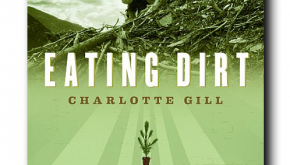
Eating Dirt: Deep Forests, Big Timber, and Life with the Tree-Planting Tribe
by Charlotte Gill
(Greystone Books, 2011)
Reviewed by Renee D'Aoust
In the acknowledgements of Eating Dirt: Deep Forests, Big Timber, and Life with the Tree-Planting Tribe, Charlotte Gill writes, “Not one word would exist [of this book] without my extended silvicultural family.” This resonates deeply because throughout, Gill captures the community of the forest in which she has planted seedlings for almost two decades. Gill eloquently threads in-depth ecological research throughout recollections of personal backbreaking experiences.
Part memoir, narrative nonfiction, and natural history, Eating Dirt manages to capture both what it feels like to engage in hard seasonal physical labor and what it might feel like if you were the forest itself. In Gill’s adept hands, we are never sentimental about any aspect of living, cutting, or planting.
Gill looks forward to her future as a writer while showing us her life as a planter:
I don’t mind reading bush maps or flying around in helicopters or driving big pickup trucks I hardly ever get cold in the rain. But I am not a natural tree planter. I have the hands of a typist. Being filthy and clammy makes me hate myself. And most of all I’d rather plant a pretty tree than a fast one. Which is one thing a tree planter should never do if she intends to earn a living.
Gill’s voice is lyrical, a song and eulogy for the replanting of trees, combined with practicality about the present and hope for the future. Much of the information will not be new to those who work intimately with trees and clear cuts, and know tree planting camps, but her words strike new yet recognizable chords.
At the end of one season, the crew leaves “this wild place before it swallows us whole.” They are not sure if they will see each other again because “planting life is only as sure as the strength of the wrist or the knee.” Gill writes:
Soon we’ll stop in Lund, a tiny coastal town, the northern most on the Sunshine Coast. We’ll get off at the government docks and find that summer has begun in our absence. We’ll see townspeople walking dogs, tourists with sweaters tied around their shoulders. Citizens will stare at us as if we are a waterfront sideshow.
When I was a teenager in the Eighties, growing up on Bainbridge Island in Puget Sound, it was a right of passage to sort fish in Alaska or to plant trees in B.C. My brother still fishes in Alaska, now with his own boat. My friend planted but had to stop. “My knees couldn’t take it,” she said.
We’re lucky Gill lasted so long to report back about all the dirty beauty of lands wrung flat. Eating Dirt: Deep Forests, Big Timber, and Life with the Tree-Planting Tribe bears witness to those local homegrown crews—and to the forests that bear the imprint of their hands.
[This book review first appeared in the Idaho Forest Owners Association Newsletter.]

